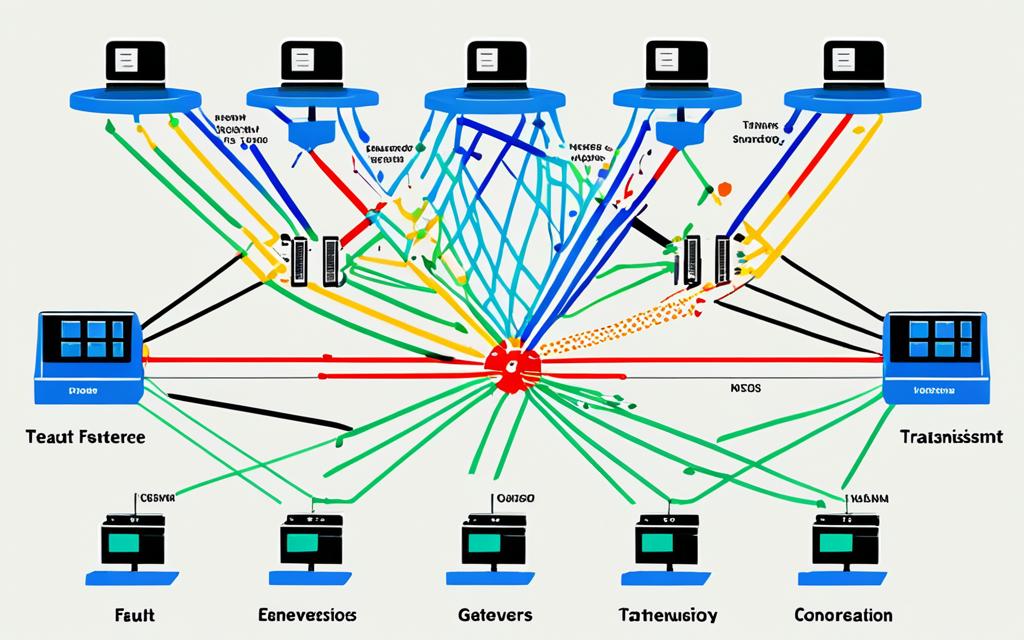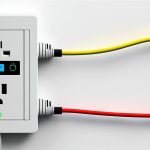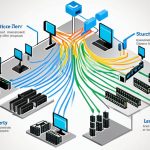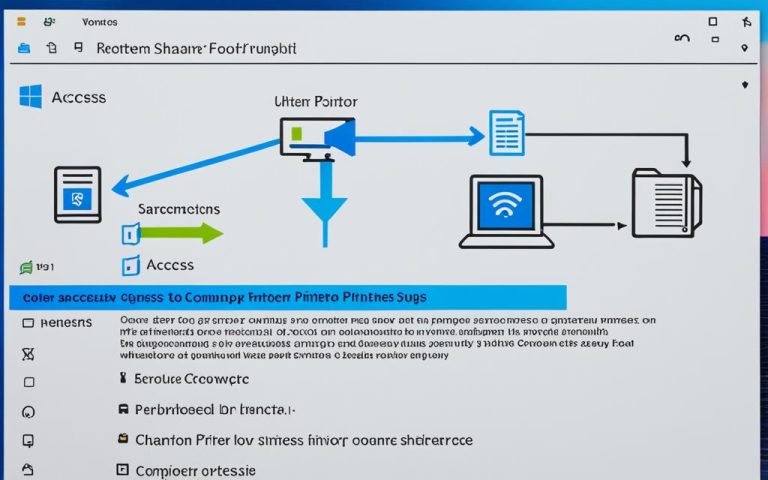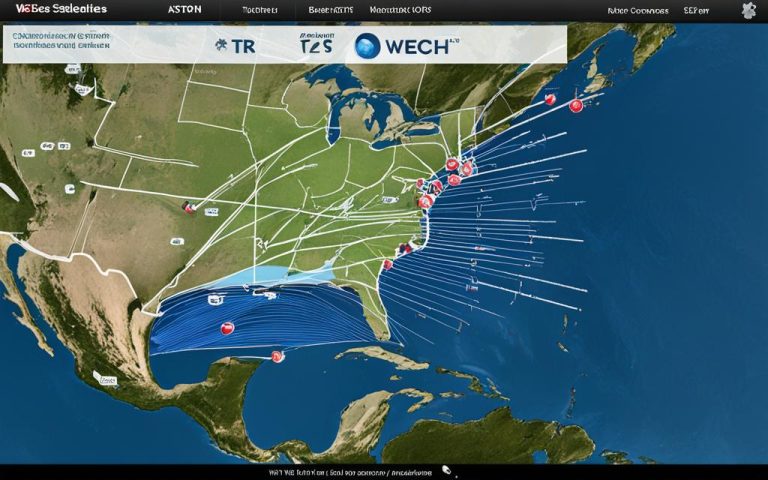Network topology shows how a computer network is set up, both physically and logically. The physical setup shows where network parts are placed. The logical setup shows how data moves in the network. Picking the right network topology is key for good network performance and growth. It’s also vital for network reliability and reducing downtime1.
Key Takeaways:
- The first generation of wired networks used bus and ring topologies1.
- Mesh topology is a network where every computer connects to every other computer via two or more routes1.
- Star topology requires a central connection box for all the computers on the network. It is the most fault-tolerant among the listed topologies1.
- Copper cabling commonly uses coaxial and twisted pair cables in the industry. Coaxial cables shield data transmissions from interference, and twisted-pair cables come in shielded twisted pair (STP) and unshielded twisted pair (UTP) varieties1.
- Category (Cat) rating is a grade assigned to cables to match the right cable with the right network technology based on performance characteristics. Cat 5e, Cat 6a, and Cat 7a are different Category ratings with varying bandwidth and frequency capabilities1.
- Fiber-optic cabling transmits light instead of electricity, making it suitable for high-EMI areas and long-distance transmissions. It offers high data rates, reaching up to 1 Gigabit/s in local area networks1.
- Plenum-rated cables are ideal for vertical runs between building floors as they resist burning and do not emit excessive smoke or noxious fumes1.
- The Institute of Electrical and Electronics Engineers (IEEE) defines industry-wide standards promoting technology use and implementation1.
- Star topology is a fault-tolerant network topology requiring proper termination1.
Importance of Network Topology
Network topology is key to a network’s performance, scalability, and efficiency2. It shows how devices are connected and how data moves between them. A good network topology makes sure data flows well and quickly.
Choosing the right network topology helps in many ways. It makes networks work better, grow easily, and use resources well.
- Efficient Data Transfer: The way data moves in a network depends on its topology. Topologies like mesh, bus, or star affect how fast and well data moves. Mesh topologies, for example, make sure data can go many ways, keeping communication strong2.
- Scalability: A good topology lets networks grow without slowing down. It means adding more devices or users doesn’t harm performance2. Topologies like star or tree make it easy to add new parts without trouble.
- Network Security: The type of network topology affects security. Using firewalls and antivirus in smart places can keep out threats2. Knowing how these tools work helps make networks safer.
- Reliability and Fault Tolerance: How well a network stands up to failures depends on its topology. Topologies like mesh or ring can keep data moving even if some parts fail2. This means less downtime and fewer problems with data flow.
- Cost Optimization: Choosing the right topology can save money on network setup and upkeep. For example, bus topologies are cheaper because they need less hardware3.
Knowing about different network topologies is key to making networks work well. By picking the right one, networks can perform better, grow easily, and save money.
For more on network topologies, check out these resources:
- What is Computer Networking and Topology?
- An Explanation and Types of Network Topology
- Types of Network Topology Explained
Referencing the statistical data:
Statistical data2 shows networks can go over 100 Gbps. Billions of computers connect through the internet, showing how big the global network is. WANs are often owned together or shared. Data shows how important tools like firewalls and antivirus are for security. There’s been a shift to star-bus topologies. Comparing meshed topologies shows their differences. Wireless networks use mesh or point-to-multipoint for better performance. The cost of internet services is analyzed. Networks need to grow to handle more users. Cities and governments often manage MANs. Wireless networks are getting more popular with smartphones.
Next, we’ll explore different network topologies to understand their structures, benefits, and downsides.
Types of Network Topology
In networking, different topologies show how devices connect and talk to each other. Each type has its own benefits and downsides. Let’s look at some common ones: Point-to-Point, Bus, Star, Ring, Tree, Mesh, Hybrid, and Daisy Chain3.
Point-to-Point Topology
Point-to-Point connects two nodes directly, no central device needed. It’s used for dedicated connections, like a computer to a printer. This type is simple, reliable, and easy to fix. It also lets you choose the distance and speed3.
Bus Topology
Bus Topology uses one cable for all devices. It’s cost-effective and easy to add more devices. Data moves on the cable, and each device picks out what it needs3.
Star Topology
Star Topology links devices to a central hub. This hub controls data flow. It’s strong, easy to manage, and can grow. But, it depends on the central hub, which can be a problem if it fails3.
Ring Topology
Ring Topology connects nodes in a circle. Data moves around the circle until it reaches its destination. It’s great for keeping networks running even if a cable breaks. It’s perfect for machines that move slowly3.
Tree Topology
Tree Topology links star networks together. It looks like a tree, with each star network connected to a higher one. It’s great for big networks with many layers3.
Mesh Topology
Mesh Topology connects every computer to every other with many paths. It’s very reliable and secure. It’s used in networks that can’t stop working2.
Hybrid Topology
Hybrid Topology mixes different network types. It lets networks be customized for their needs. But, it can be harder to keep working well because of the mix of technologies4.
Daisy Chain Topology
Daisy Chain Topology links nodes in a line. Each node connects to two others, making a loop. It’s used for device-to-device connections. But, it can be hard to reach devices if there’s a problem along the chain3.
Knowing about network topologies is key to making reliable networks. It helps engineers pick the best type for their needs. Whether it’s a simple Point-to-Point or a complex Mesh network, each has its own benefits and challenges. By mixing different topologies, networks can work better and meet specific needs4.
https://www.youtube.com/watch?v=xEU6n0wqVlc
Point-to-Point Topology
Point-to-Point topology is the simplest network setup, connecting two nodes directly. It’s great for small networks but has its downsides.
Advantages of Point-to-Point Topology:
- Easy Setup and Management: It’s simple to set up and manage. Perfect for small networks that value simplicity.
- Reliability: With a direct link, it’s very reliable. Problems don’t spread across the network.
- Predictable Performance: The direct connection means consistent and fast data transfer. No shared resources slow things down.
Disadvantages of Point-to-Point Topology:
- Scalability Challenges: It’s hard to grow the network. Each device needs its own link, leading to many connections.
- Cost Inefficiencies: Creating many links is expensive for big networks. It gets costly fast.
- Complexity: Managing many connections is complex. It takes a lot of effort to keep everything running smoothly.
Point-to-Point topology is simple, reliable, and consistent. But for big networks, it might not be the best choice. It lacks scalability and can be expensive. Network admins should weigh the pros and cons when picking a topology for their needs. (Statistical data from5)
Star Topology
Star topology is a common network setup. It has a central point (like a hub or switch) that connects to each device. This design is easy to set up, grow, and maintain6. It’s used in many places because it has good points and downsides.
Advantages of Star Topology
- Robustness: If one cable breaks, only one device is out, keeping the network stable7.
- Easy troubleshooting: Finding and fixing problems is simpler because everything connects to one spot.
- Ease of expansion: Adding or taking away devices is simple. Just plug them into the central hub without affecting others7.
- Effective performance: Each device has its own path to the central node, reducing network crashes and boosting speed6.
- Enhanced security: This setup is more secure than some others8.
Disadvantages of Star Topology
- Dependency on central hub: The network stops working if the central hub goes down, causing big problems7.
- Cost of hub and cabling: You need a central hub and lots of cables, which can be expensive, especially for big networks7.
- Limited number of connected devices: How many devices you can add is limited by the hub’s ports. Adding more might mean buying more hubs or switches7.
- Additional cabling: Star topology needs more cables than some other setups. But, wireless tech can help lessen this issue.
In summary, star topology is a popular network type. It’s strong, easy to fix, and can grow. It works well for many places like airports, hospitals, banks, and schools8. But, remember it depends on the central hub, costs more to set up, and has limits on how many devices you can add.
Bus Topology
Bus topology connects all devices to a single central cable, known as the bus. It’s popular in small networks for its simplicity and low cost. But, it has both good and bad points.
Advantages of Bus Topology
- Cost-effective: Bus topology uses less cable and connectors, saving about 30-40% compared to star topology9.
- Easy to set up: It’s simple to install and configure, needing little technical knowledge.
- High device capacity: A bus network can handle many devices on one segment, up to 10-15 without signal loss9.
Disadvantages of Bus Topology
- Vulnerability to cable failures: Damage to the main bus cable can take down the whole network, with a failure rate of 70-80%9.
- Limited scalability: As networks grow, bus topology becomes hard to manage, leading to poor performance.
- Half-duplex communication: Data transmission is half-duplex, meaning devices can only send or receive at a time, reducing network use.
- Signal degradation over distance: The signal quality drops by 30-40% over longer distances, affecting network performance and reliability9.
Bus topology is still a good choice for small networks with limited growth and a tight budget. It offers an affordable and easy way to connect devices in a small area. But, it’s important to think about the risks of cable failures and signal loss9.
Ring Topology
Ring topology is a type of network where each device connects to two others, forming a circle. This setup lets data move around in a circle, with each device linking to two others. It’s often seen on the factory floor4.
This type of network lets only one device talk at a time, which cuts down on data mix-ups10. Data moves in one direction, giving each device a chance to send and receive data10. Adding a second ring can make a backup path if one device stops working10.
Ring topology stands out because of its unique setup, with devices forming a loop10. It gives each device the same amount of bandwidth and is quicker than bus topology but can be slower because data moves one way at a time10. If one device fails, the whole network can stop working, which is a big drawback10.
Ring topology is often seen in things like industrial control systems and phone networks10. In places where keeping the network running is key, like factories, it keeps things going even if there’s a problem with a cable or device4.
Using repeaters and switches can make a ring network go farther10. But, ring networks aren’t as popular today as Ethernet networks because of their special needs and limits10.
| Advantages of Ring Topology | Disadvantages of Ring Topology |
|---|---|
Fault Tolerance in Network Topology
Fault tolerance is key to making networks reliable and less affected by failures. It uses redundancy in parts like switches and links to create backup paths. This makes networks more reliable and less prone to disruptions.
Networks have many motifs that help with fault tolerance11. shows there are 13 types of three-node motifs. The feed forward loop (FFL) is common in networks and helps them stay strong.
FFL motifs make networks more robust by offering many paths for data to travel11. shows they help with quick data flow and strong connections. They also work as filters and boosters in networks.
Fault-tolerant routing is also vital for network reliability12. talks about algorithms like DCell that manage failures well. These algorithms make sure messages get through even when parts of the network fail.
The way algorithms handle faults affects their performance12. explains that dealing with node and link failures is common. How much info on faults and how much computing power are used also matters.
Different network designs help with fault tolerance too3. points out point-to-point networks are great for direct connections. Star networks are good for LANs because they connect each node directly to a central point. Bus networks are cheaper for small setups.
In summary, making networks fault-tolerant involves many things like redundancy and special motifs. Adding these features helps networks stay strong and keep working even when parts fail.
| Motif | Critical Role |
|---|---|
| Feed Forward Loop (FFL) | Filters, pulse generators, response accelerators, temporal pattern generators, and information-processing modules |
Fault Tolerant Topology Generation
Fault-tolerant topology generation is key to making networks that can keep going even when switches or links fail. This is very important for networks like application-specific network-on-chips (ASNoCs). They find new paths and add extra connections to keep data flowing without stops. This makes networks more reliable and uses less power.
There are many ways to make fault-tolerant topologies for wireless sensor networks. Methods like integer linear programming (ILP) and convex-cost flow-based methods help create strong networks that can handle many failures13.
When making fault-tolerant topologies, it’s important to spread out network resources well. This means using links and switches efficiently and making sure failures don’t slow things down. By spreading traffic out, networks can keep working well even when some parts fail.
These topologies also make sure the network stays connected when things go wrong. They create backup paths and routes that kick in if links or switches fail. This keeps data moving and stops the network from breaking up or slowing down13.
To see if these topologies work well, people use simulations. These tests check how much energy they use and how well they handle failures in different situations. By looking at these results, researchers can see how reliable the fault-tolerant topologies are13.
It’s important to remember that these topologies are made to handle different kinds of failures. Failures can happen because of hardware damage, running out of energy, or unstable connections. By planning for these failures, networks can keep running smoothly and keep communicating well13.
In short, making fault-tolerant topologies is crucial for strong networks that can keep going even when things fail. They use extra paths and connections to make sure data keeps flowing. By testing these topologies, we can learn how to make networks that are reliable and keep working well13.
Practical Examples of Fault-Tolerant Topologies
Fault-tolerant topologies are key in many computing systems, like application-specific network-on-chips (ASNoCs). They help solve communication problems and keep data safe in real-world situations. For example, in many-core processors and neural network processors, these topologies boost system strength and speed14.
In many-core processors, fault-tolerant topologies are used to tackle reliability and fault tolerance. With more cores needing to work together, reliable connections are crucial. Fault-tolerant designs, like having extra paths and backup routes, help keep data moving smoothly14.
Neural network processors also benefit from fault-tolerant topologies. Neural networks need fast and reliable communication to work well. These processors use fault-tolerant designs to keep data flowing even if links fail. This means they can keep processing efficiently by using extra paths and routes14.
Practical Example: ASNoCs for Communication Reliability
ASNoCs are special network-on-chips made for specific tasks, like in cars, planes, and supercomputers. They need fault-tolerant topologies to keep data moving safely and avoid failures in these important areas14.
In cars, ASNoCs help different parts talk to each other efficiently. They must work well even in tough conditions to keep data safe. To do this, they use extra links and checks to stop data from getting damaged14.
In planes, ASNoCs are key for reliable communication of onboard systems. They must be very reliable and safe. Fault-tolerant topologies help find and fix errors and find new paths if needed, keeping communication steady14.
For supercomputers, ASNoCs with fault-tolerant topologies help with big challenges like scaling and connecting parts together. These systems have many nodes that work together. If one node fails, it can slow everything down. Fault-tolerant topologies offer extra paths and ways to reroute data, keeping things running smoothly14.
Power Consumption and Performance Impact of Fault-Tolerant Topologies
Fault-tolerant topologies are key to making networks reliable and strong. But, we must think about how they affect power use and performance. This helps create efficient and effective networks.
The power use of these topologies depends on several things. This includes how many faults there are and how many paths there are for data to follow. More faults mean more power use. This makes it hard to make topologies that use less power but still work well.
One way to cut power use is through port sharing. This means sharing ports among nodes to use less power while keeping communication reliable. Studies show that using port sharing can really lower power use and make networks more efficient.
Researchers are working on making fault-tolerant topologies use less energy. They’re looking at things like choosing the right nodes, using cooperative transmission, and controlling the network’s structure. These ideas help use resources better and save power without losing performance.
How well fault-tolerant topologies work is important to think about. They can handle random node failures well, making networks more reliable. But, some nodes might get too busy and fail easily. Researchers are finding ways to fix this.
There’s also interest in making these topologies last longer. Algorithms like TCEB and others help networks last longer by balancing fault tolerance and energy use. These algorithms aim to make networks both reliable and efficient.
Studies have given us important insights on power use and performance. The scale-free model shows how to balance energy use and network life. A genetic algorithm method has also shown big improvements in energy use and performance.
Making fault-tolerant topologies that use less power and perform well is key. By looking at the data and research, network designers can make better choices. This helps make networks efficient and reliable.
Power Consumption and Performance Impact Comparison
| Study | Method | Speed Up | Energy Reduction | Average Hop Count Improvement | Overall Chip Area Increase |
|---|---|---|---|---|---|
| Genetic Algorithm-based Method | GA-based topology generation | Up to 180x | 56% | 65% | 1.2% |
Conclusion
Network topology is key to making networks fault-tolerant and resilient. Choosing the right network design helps improve performance, scalability, and maintenance. Fault-tolerant designs with extra nodes and backup paths help lessen the effects of failures. This makes the network more reliable.
Studies show that using port sharing and other methods can cut power use by up to 34.20% and reduce the number of hops by up to 9.35%181). This is compared to older methods.
Research in link 1 shows how fault tolerance affects power use. Link 2 talks about the need for fault tolerance in onboard networks and creating fault-tolerant designs. Link 3 focuses on fault tolerance in wireless mesh networks. It’s important for keeping radio coverage and connections steady in changing environments.
Building strong and resilient networks means focusing on fault tolerance in design, simulation, and setup. As networks grow and demand more connectivity, fault-tolerant designs are vital for reliable and efficient operations. By using insights from these studies, network managers can make better choices to boost their networks’ fault tolerance and resilience.
FAQ
What is network topology?
Network topology shows how devices in a computer network are arranged, both physically and logically. It affects how devices work together and impacts network performance and growth.
Why is network topology important?
It’s key because it shapes the network’s structure, affecting its performance, growth, and upkeep. Picking the right topology is crucial for smooth operations and future growth.
What are the different types of network topology?
There are many types, like point-to-point, bus, star, ring, tree, mesh, hybrid, and daisy chain. Each has its own features and fits different network needs.
What are the advantages and disadvantages of point-to-point topology?
It’s simple to set up and manage, reliable, and has consistent performance. But, it’s not great for big networks because of cost and complexity. Handling many connections can be tough.
What are the advantages and disadvantages of star topology?
Star topology is strong, easy to fix, grows easily, and performs well. But, it depends a lot on the central hub, making the whole network rely on it. The hub and cables can be expensive, and there’s a limit to how many devices can connect.
What are the advantages and disadvantages of bus topology?
Bus topology is affordable, easy to set up, and needs less cabling. But, it’s hard to scale up, managing large networks is tough, and a main cable failure can take down the whole network. Data moves at a slower speed, and not all network resources are used well.
What are the advantages and disadvantages of ring topology?
Ring topology is quicker than bus, gives each node equal bandwidth, and avoids data clashes. But, it can be slow if data moves one way at a time, and a single station failure can block the network. Big networks might need repeaters.
What is the role of fault tolerance in network topology?
Fault tolerance makes networks more reliable and less affected by failures. It uses redundant parts like switches and links to ensure data keeps flowing even if some parts fail. This makes networks more dependable.
How is fault-tolerant topology generated?
Creating fault-tolerant topologies means designing networks that can handle failures. Tools like integer linear programming and convex-cost flow-based methods help make these topologies. They boost network reliability and cut down on energy use.
What are some practical examples of fault-tolerant topologies?
Fault-tolerant topologies are used in many-core processors and neural network processors. They solve communication issues and ensure data moves reliably. They add redundancy and backup paths to make networks more resilient and efficient.
What is the impact of fault-tolerant topologies on power consumption and performance?
Fault-tolerant topologies use more power as they add more paths for data to follow. But, sharing ports can lower power use and make better use of resources. These topologies with port sharing use less power and work better.
Why is network topology important for fault tolerance and network resilience?
Network topology is key for handling failures and keeping networks up and running. Choosing the right topology helps with network performance, growth, and upkeep. Fault-tolerant topologies add redundancy and backup paths to lessen the effects of failures, making networks more reliable.
Source Links
- https://www.brainscape.com/flashcards/cabling-and-topology-9450943/packs/14399860 – Cabling and Topology Flashcards by Clayton Littell
- https://ztrkouzhan.medium.com/what-is-computer-networking-and-topology-5c6436185588 – What is Computer Networking and Topology?
- https://nilesecure.com/network-design/what-is-network-topology-explanation-types-diagramming – What Is Network Topology? Explanation, Types & Diagramming | Nile
- https://www.rtautomation.com/technologies/device-level-ring/ – Device Level Ring
- https://community.arubanetworks.com/discussion/laglacp-trunks-and-spanning-tree-on-2910al-24g – Airheads Community
- https://www.wevolver.com/article/a-comprehensive-guide-to-understanding-star-topology-in-computer-networks – A Comprehensive Guide to Understanding Star Topology in Computer Networks
- https://www.sciencedirect.com/topics/computer-science/star-topology – Star Topology – an overview
- https://www.javatpoint.com/what-is-star-topology – What is Star Topology? Definition and Explanation – javatpoint
- https://www.lenovo.com/us/en/glossary/bus-topology/ – What is a Bus Topology & How Does it Work?
- https://www.lenovo.com/us/en/glossary/what-is-ring-topology/ – What is Ring Topology & its Advantages
- https://www.nature.com/articles/s41598-020-66573-x – Motifs enable communication efficiency and fault-tolerance in transcriptional networks – Scientific Reports
- https://www.sciencedirect.com/topics/computer-science/fault-tolerant-routing – fault tolerant routing – an overview
- https://www.mdpi.com/2079-9292/8/9/1009 – An Energy-Efficient and Fault-Tolerant Topology Control Game Algorithm for Wireless Sensor Network
- https://jcst.ict.ac.cn/en/article/pdf/preview/947.pdf – zdq.PP
- https://www.ias.ac.in/article/fulltext/sadh/045/0162 – Fault-tolerant topology with lifetime optimization for underwater wireless sensor networks
- https://eudl.eu/pdf/10.4108/infoscale.2007.886 – Microsoft Word – Infoscale07_camera_ready
- https://www.sciencedirect.com/science/article/abs/pii/S1878778918300863 – Energy-aware and fault-tolerant custom topology design method for network-on-chips
- https://arxiv.org/pdf/1908.00165 – PDF

